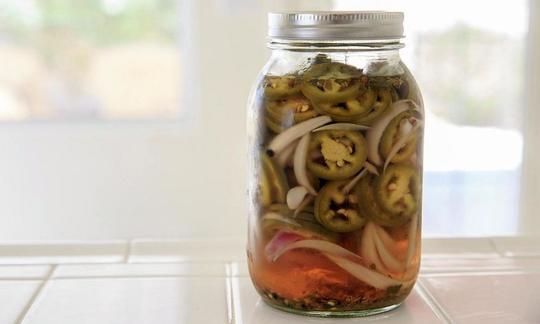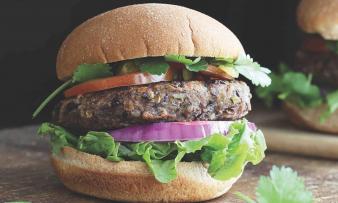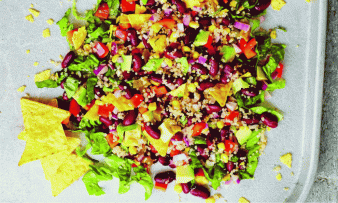Table of contents
Pickled jalapeños ( Capsicum annuum) are a good way to preserve hot peppers. They are found in this form mainly in Europe, but this type of preservation is also known in the USA and Mexico.
Use in the kitchen:
The jalapeño (not jalapeno or chalapeno) is a hot, small or medium-sized pepper variety. The peppers are available pickled in vinegar - either whole or cut into small rings (as "sliced jalapeños"). In Mexico, almost only green jalapeños are used. The red, ripe jalapeños have a slightly spicier aroma, a sweet taste and are slightly hotter.
Raw jalapeños taste great in tomato salad, sprinkled over nachos, in sauces or dips like guacamole. But the Mexican flavor also comes through very well in the pickled form and you can use them in a similar way. Pickled jalapeños are a good spicy side dish for almost all Mexican dishes like tacos, tortillas or rice dishes. In the USA they are also eaten with pizza or burgers. Jalapeños also work well in soups, stews or anywhere you need something spicy.
Sometimes the vinegar used for pickled jalapeños is a bit too acidic. If you are sensitive to this, you can choose a suitable vinegar and marinate the raw fruits in it yourself to preserve them.
Jalapeños are not very suitable for air drying because the flesh is very thick. The ripe, red fruits can be preserved by smoking. After this preservation process, jalapeños are then called chipotles.
Recipe for pickled jalapeños (vegan):
The fleshy consistency of the small pepper variety is ideal for preserving. The pods can be frozen or pickled. For the pickled version, you need 350 g of fresh, beautiful jalapeños, 500 ml of water, 500 ml of vinegar, 1 teaspoon of sugar, 1 teaspoon of salt and 1 tablespoon of mustard seeds. After washing, remove the stems and cut the fruit into strips or slices. The seeds are also used when pickling. It is advisable to wear gloves, otherwise the spiciness will stick to your fingers. Now fill the sliced jalapeños into sterilized, small jars. Put the other ingredients in a large pot and let the liquid simmer for a few minutes. Now fill the jars with this hot broth. After filling and closing, turn the jars upside down for a few minutes. After about four weeks, the pickled jalapeños get their typical consistency. 1
| Not only vegans or vegetarians should read this: Vegans often eat unhealthily. Avoidable nutritional errors. |
Shopping - where to buy?
Pickled jalapeños are usually available in jars and sometimes in cans in supermarkets. Major retailers such as Coop, Migros, Spar, Rewe, Edeka stock the spicy canned goods in their range. Denner, Volg, Aldi, Lidl, Hofer etc. only sometimes do. In health food stores, organic shops or online you can also find pickled jalapeños in organic quality, sliced or as whole organic fruits.
In Europe, fresh, green jalapeños are rarely found at weekly markets or in some supermarkets. They usually come from greenhouses in the Netherlands or Israel. 2
Storage:
Pickled jalapeños will last for around 1 year if kept sealed and stored in a cool, dark place. If the liquid appears cloudy, they are no longer edible. Once opened, the jars can be kept in the fridge and consumed after a few days. Stored pickled jalapeños sometimes contain other spices and often citric acid. Once opened, however, they will only last a maximum of 1 week.
Ingredients - nutritional value - calories:
How healthy are jalapeños? Pickled jalapeños have a very low energy content of 27 kcal. Because of the vinegar marinade, preserved jalapeños often contain too much salt. This content can be massively reduced with the homemade version. The information in the nutritional tables refers to the purchased product.
The vitamin C content of the fresh jalapeño is significantly higher at 119 mg/100g than that of the strawberry (59 mg/100g). The pickled jalapeño only has 10 mg/100g. However, people usually don't eat large quantities of either the fresh or the preserved spicy fruit. 3
The spicy taste comes from the capsaicin it contains. This alkaloid is found in many types of peppers in varying degrees. The Scoville scale is used to determine the spiciness. With a content of between 2500 and 8000 Scoville units, jalapeños are still far behind the habanero pepper (100,000-500,000 Scoville). 2
Health aspects - effects:
Spicy foods are said to have a blood pressure-lowering effect and the risk of blood clots is said to decrease with regular consumption. The spicy alkaloid capsaicin has shown a reducing effect on bad LDL cholesterol in animal experiments at the Chinese University of Hong Kong. Capsaicin is also said to reduce deposits in blood vessels. 4
Dangers - Intolerances - Side effects:
If you have a sensitive stomach or intestines or don't tolerate spicy food well, you should avoid jalapeños. Spicy food triggers increased production of gastric juices and this can lead to heartburn. Stomach acid flows back into the esophagus and leaves a burning pain behind the breastbone.
Folk medicine - natural medicine:
The capsaicin contained in it is said to promote blood circulation and help against infections and digestive problems. 5
Occurrence - Origin:
Jalapeños are mainly cultivated in Mexico and the USA. Approximately 60% of the harvest is processed, 20% is sold fresh and 20% is sold as chipotles. 2
Growing in the garden - harvesting:
The best place to germinate the jalapeño seeds is indoors and in small, protected containers. After the last frost (in May), the young plants can be planted outside at a distance of about 30 cm. Depending on the climate, the first fruits ripen after 2-3 months. Jalapeños are harvested green, just before they turn red. In warm climates and with plenty of sun, one plant can produce between 50 and 100 fruits. 6 Jalapeños often have long, woody-looking "scars"; this corking forms on ripe or almost ripe fruits and is considered a sign of quality in Mexico. 7
General information:
The jalapeño is a variety of Spanish pepper ( Capsicum annuum, also known as paprika). As with chili varieties, there are many different special varieties and variations of jalapeños. Although they are all called jalapeños, there are differences in aroma, level of spiciness, size and fruit color. 7 According to Wikipedia, there is also a variety that is not spicy. This variety was bred at the Chile Pepper Institute at New Mexico State University and called "Primavera".
The name Jalapeño comes from the Mexican city of Xalapa (capital of the state of Veracruz), formerly Jalapa, in whose vicinity jalapeños were once traditionally grown.
Literature - Sources:
Bibliography - 7 Sources (Link to the evidence)
| 1. | Utopia.de Jalapeños einlegen Grundrezept und leckere Variationen. |
| 2. | Wikipedia Jalapeño. |
| 3. | USDA United States Department of Agriculture. |
| 4. | Liang YT, Tian XY et al. Capsaicinoids lower plasma cholesterol and improve endothelial function in hamsters. Eur J Nutr. PubMed. 2013;52(1). |
| 5. | Eatsmarter.de Jalapeño. |
| 6. | Pepperworld.de Jalapeño Chili Sorte. |
| 7. | Wildcapsicum.org Jalapeño. |










Comments